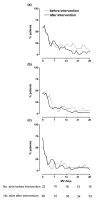Mechanical ventilation with lower tidal volumes does not influence the prescription of opioids or sedatives
- PMID: 17629900
- PMCID: PMC2206517
- DOI: 10.1186/cc5969
Mechanical ventilation with lower tidal volumes does not influence the prescription of opioids or sedatives
Abstract
Introduction: We compared the effects of mechanical ventilation with a lower tidal volume (V(T)) strategy versus those of greater V(T) in patients with or without acute lung injury (ALI)/acute respiratory distress syndrome (ARDS) on the use of opioids and sedatives.
Methods: This is a secondary analysis of a previously conducted before/after intervention study, which consisting of feedback and education on lung protective mechanical ventilation using lower V(T). We evaluated the effects of this intervention on medication prescriptions from days 0 to 28 after admission to our multidisciplinary intensive care unit.
Results: Medication prescriptions in 23 patients before and 38 patients after intervention were studied. Of these patients, 10 (44%) and 15 (40%) suffered from ALI/ARDS. The V(T) of ALI/ARDS patients declined from 9.7 ml/kg predicted body weight (PBW) before to 7.8 ml/kg PBW after the intervention (P = 0.007). For patients who did not have ALI/ARDS there was a trend toward a decline from 10.2 ml/kg PBW to 8.6 ml/kg PBW (P = 0.073). Arterial carbon dioxide tension was significantly greater after the intervention in ALI/ARDS patients. Neither the proportion of patients receiving opioids or sedatives, or prescriptions at individual time points differed between pre-intervention and post-intervention. Also, there were no statistically significant differences in doses of sedatives and opioids. Findings were no different between non-ALI/ARDS patients and ALI/ARDS patients.
Conclusion: Concerns regarding sedation requirements with use of lower V(T) are unfounded and should not preclude its use in patients with ALI/ARDS.
Figures


Similar articles
-
Adoption of lower tidal volume ventilation improves with feedback and education.Respir Care. 2007 Dec;52(12):1761-6. Respir Care. 2007. PMID: 18028568 Clinical Trial.
-
Use of sedatives, opioids, and neuromuscular blocking agents in patients with acute lung injury and acute respiratory distress syndrome.Crit Care Med. 2008 Apr;36(4):1083-8. doi: 10.1097/CCM.0B013E3181653895. Crit Care Med. 2008. PMID: 18401254
-
Lung-protective mechanical ventilation with lower tidal volumes in patients not suffering from acute lung injury: a review of clinical studies.Med Sci Monit. 2008 Feb;14(2):RA22-26. Med Sci Monit. 2008. PMID: 18227773 Review.
-
Lung protective ventilation strategies: have we applied them in trauma patients at risk for acute lung injury and acute respiratory distress syndrome?Am Surg. 2007 Apr;73(4):347-50. Am Surg. 2007. PMID: 17439026
-
Ventilator or physician-induced lung injury?Minerva Anestesiol. 2005 Jun;71(6):255-8. Minerva Anestesiol. 2005. PMID: 15886585 Review.
Cited by
-
Initial ventilator settings for critically ill patients.Crit Care. 2013 Mar 12;17(2):123. doi: 10.1186/cc12516. Crit Care. 2013. PMID: 23510269 Free PMC article.
-
High tidal volume ventilation is associated with ventilator-associated pneumonia in acute cervical spinal cord injury.J Spinal Cord Med. 2021 Sep;44(5):775-781. doi: 10.1080/10790268.2020.1722936. Epub 2020 Feb 11. J Spinal Cord Med. 2021. PMID: 32043943 Free PMC article.
-
Low tidal volume ventilation use remains low in patients with acute respiratory distress syndrome at a single center.J Crit Care. 2018 Apr;44:72-76. doi: 10.1016/j.jcrc.2017.10.021. Epub 2017 Oct 18. J Crit Care. 2018. PMID: 29073535 Free PMC article.
-
Limiting sedation for patients with acute respiratory distress syndrome - time to wake up.Curr Opin Crit Care. 2017 Feb;23(1):45-51. doi: 10.1097/MCC.0000000000000382. Curr Opin Crit Care. 2017. PMID: 27898439 Free PMC article. Review.
-
Respiratory effects of different recruitment maneuvers in acute respiratory distress syndrome.Crit Care. 2008;12(2):R50. doi: 10.1186/cc6869. Epub 2008 Apr 16. Crit Care. 2008. PMID: 18416847 Free PMC article. Clinical Trial.
References
Publication types
MeSH terms
Substances
LinkOut - more resources
Full Text Sources

